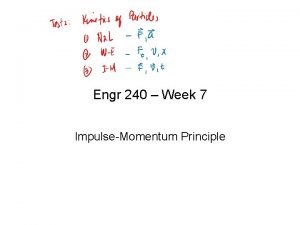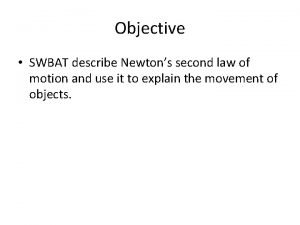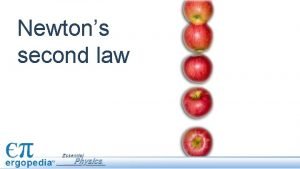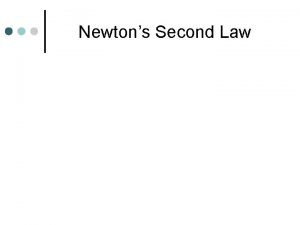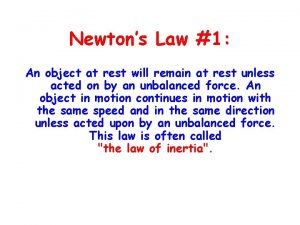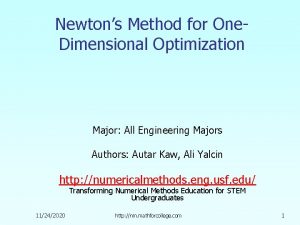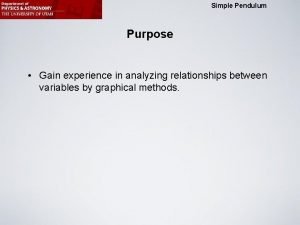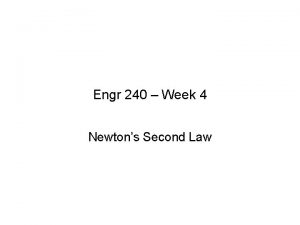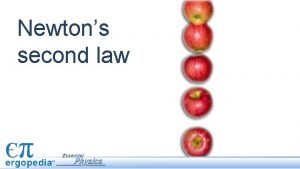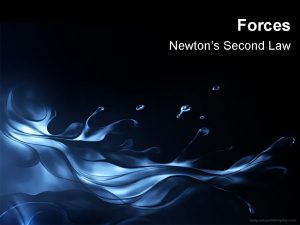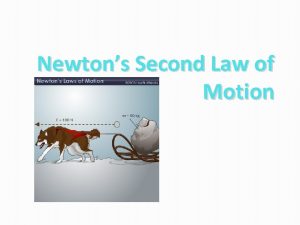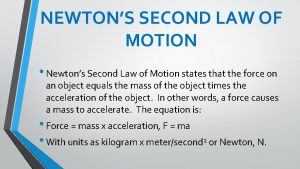Engr 240 Week 5 Newtons Second Law Curvilinear












- Slides: 12

Engr 240 – Week 5 Newton’s Second Law: Curvilinear Motion

• Newton’s second law provides • For rectangular components, • For tangential and normal components,

Example 1: Packages each of mass m are delivered from a conveyor belt to a smooth circular ramp with a velocity of vo=1 m/s. Determine the angle = max at which the package begins to leave the surface.


Radial and Transverse: where Scalar Equations:

Example 2. The smooth bar rotates in the horizontal plane with a constant angular velocity o. The unstretched length of the spring is ro. The collar A has mass m and is released at r=ro with no radial velocity. Determine (a) vr(r), and (b) the horizontal (transverse) force exerted by the bar as a function of r.


Angular Momentum of a Particle • • moment of momentum or the angular momentum of the particle about O. is perpendicular to plane containing • Derivative of angular momentum with respect to time, • It follows from Newton’s second law that the sum of the moments about O of the forces acting on the particle is equal to the rate of change of the angular momentum of the particle about O.

Conservation of Angular Momentum • When only force acting on particle is directed toward or away from a fixed point O, the particle is said to be moving under a central force. • Since the line of action of the central force passes through O, • Position vector and motion of particle are in a plane perpendicular to • Magnitude of angular momentum, or

Conservation of Angular Momentum • Radius vector OP sweeps infinitesimal area • Define areal velocity • Recall, for a body moving under a central force, • When a particle moves under a central force, its areal velocity is constant.

Example: Problem 12. 8 A satellite is launched in a direction parallel to the surface of the earth with a velocity of 18820 mi/h from an altitude of 240 mi. Determine the velocity of the satellite as it reaches it maximum altitude of 2340 mi. The radius of the earth is 3960 mi. SOLUTION: • Since the satellite is moving under a central force, its angular momentum is constant. Equate the angular momentum at A and B and solve for the velocity at B.

 Perfectly plastic collision
Perfectly plastic collision Newton's first law of motion in soccer
Newton's first law of motion in soccer Describe newtons second law
Describe newtons second law Newton's 2nd law
Newton's 2nd law Newton's 2nd law of motion examples
Newton's 2nd law of motion examples Newtons second law
Newtons second law Newtons second law example
Newtons second law example Newton's first law and second law and third law
Newton's first law and second law and third law Newton's first law of motion
Newton's first law of motion Newtons second kaw
Newtons second kaw Newtons second kaw
Newtons second kaw Newtons second laq
Newtons second laq Newtons third lw
Newtons third lw
